 |
Electricity Sub-Stations:
by Duncan Nimmo |
 |
Electricity Sub-Stations, particularly of the inter-War period, are an inconspicuous, yet widespread and characteristic feature of the Wolverhampton landscape, in both suburbs and city centre. Modest structures though they are, they are, as a class, of considerable interest both architecturally and historically.
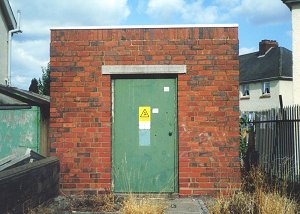 1. Thorne Road
1. Thorne Road |
In Wolverhampton, as elsewhere, the spread of
electricity was a key historical and social development of the
first half of the 20th
century, fostered by the vision and energy of the Borough
Council.
The Sub-Stations were an essential instrument of that development, and remain its chief physical monument. As early as 1914 their role was recognised in the town's Red Book: "Several Sub-stations have been built to contain converting machinery for supplying districts a long way from the Generating Station". |
At the other end of the period, each step in the march of new housing towards the boundaries of the borough in north, west and south was marked by the erection of a local station or stations.
Sub-station design
The key architectural feature of the Sub-Stations is that they are perfect small-scale examples of good quality contemporary building style and materials.
| The most basic design feature of the Sub-Stations
illustrated is a more or less close approximation to the cube.
There is one interesting exception, the Minerva Lane Station (9);
this could be considered a cube considerably elongated, and with
one corner cut at an angle.
Two basic sizes occur, comparable to a small and large domestic garage, alternatively identifiable as 1-door (1, 2) and 2-door (3-16). A further fundamental distinction relates to roof type: roughly two thirds (1-11) are flat, and one third (12-16) sloping. |
2. Amos Lane, by Wednesfield Park |
Diversity/Detailing vs. Uniformity.
Sixteen Stations are illustrated. No two (with the partial exception of nos. 7 and 8) are the same. In other words, such attention has been paid to distinctive detailing that each one is individual.
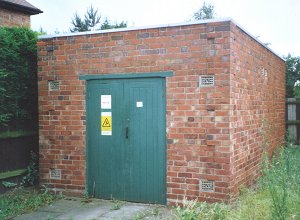
3. Stubby Lane |
This emphasis on individuality within a basic
uniformity is a prime characteristic of contemporary building,
particularly in the private suburban estates, and is among the
Sub-Stations, most attractive features. Yet, on the assumption
that all belonged to Wolverhampton Borough, why they were so
varied is an intriguing and so far unanswered question.
The point is sharpened by the fact that there were at least two standard designs of Sub-Station, and possibly more. The two are seen in illustrations 7 and 13; I have so far come across 3 apparently identical buildings to each of these. |
| The key to such standardisation is displayed by the type in illustration 7: the concrete plaque inserted into the lintel, with the letters W. C. E. D. and the date. Thus did the Wolverhampton Corporation Electricity Department proudly declare its handiwork. The dates of the 4 cases I have encountered range from 1932 to 1934; possibly this particular design held the field for a relatively short period around those years. The question is complicated by illustration 8, for here we have an apparently identical building, except that the plaque is missing. Was this one an earlier, or later, version - or just an aberration? |
4. Wakeley Hill |
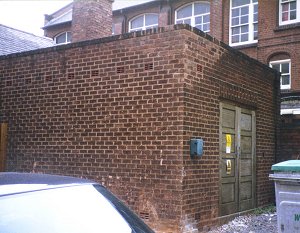
5. Old Hall Street. The location and brickwork suggest this was built for the Savoy Cinema (now the Atlantis night club) which opened in 1937. |
The W. C. E. D. marked some of its Sub-Stations; it looks as though the Midland Electricity Corporation identified all, again by the insertion of a concrete plaque, this time bearing, not mere initials, but a logo, a small classic of its period and kind. Although eroded, this can just be made out in illustration 2. A roundel is set within a square; the initials MEC appear at the top; reaching up from the bottom towards them are stylised flashes of lightning or electricity, and between these, one on either side, are the words "ELECTRIC SERVICE". The dozen or so MEC Sub-Stations I have spotted, from Wednesfield to Quarry Bank, come in a range of shapes and sizes; but all carry this instantly recognisable logo. |
Here is another small element of uniformity in this varied class of building, as well as important evidence of the corporate pride of their creators.
The "Modernist" Group.
The hallmark of an unspectacular, but pervasive inter-War modernism was a geometrical plainness, with a particular emphasis upon the horizontal, and which both enhances and is enhanced by subtle detailing in the use of brick and stone. Perhaps the most obvious element of the style was the flat roof, since this automatically enshrined the geometrical and horizontal.
| Eleven of the sixteen Sub-Stations illustrated
possess this feature, which, reinforced by the geometry of their
essentially cubic shape, declares them unequivocally modernist.
In every case, even the smallest (1, 2), the flat roof is highlighted by a particular, often quite subtle emphasis on the cornice: this is generally achieved by the use of stone or an equivalent to contrast with the basic brickwork, but even where the material is brick, it is laid in such a way as to stand out (5). Horizontals are repeatedly picked out, in the simplest cases with a lintel (1, 2, 3), often with one or more stringcourses, generally in a contrasting material such as tiles or stone (4, 7, 8, 10, 11). |
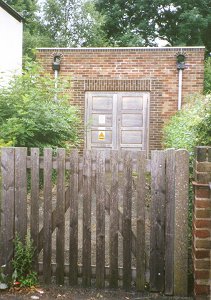
6. Coppice Road, opposite Fir Tree Road |
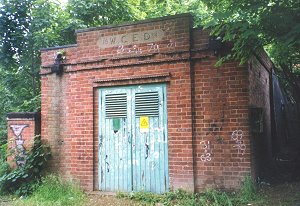
7. off Penn Road, north of Woodfield Avenue |
In general, interest and distinction are added to
fundamentally very simple structures not only by decorative use of
materials, but also by variations in height, or the "stepping" of
parallel surfaces.
Thus even the two smallest, "single-door" Sub-Stations - barely larger than a garden shed - make use of that typical modernist device, vertically placed, or "soldier" bricks, and the second raises the cornice above the door-way (1, 2). |
|
The doorway facade is overall the point of maximum interest and diversity, benefitting from numerous variations in materials, and "stepping" both horizontal and vertical (4, 6, 7, 8, 10, 11). Apart from the purpose of giving prominence to the main facade, decorative use is made of materials as it were for its own sake, simply to add variety and interest; thus for instance the central panel of tiles in illustration 10, the rustication of wall-angles in illustration 11. |
8. Langley Road |
However most striking in this regard, despite its poor state of preservation, is perhaps the Minerva Lane building (9). Here the brick "columns" dividing the facade, together with their stone "capitals", the rectangular windows carefully delineated in stone, and the elements of a stone stringcourse, add up to a stylish modernist statement.
The "Domestic" Group.
The last 5 Sub-Stations illustrated, besides the two larger electricity buildings shown, have sloping roofs. This feature immediately removes them from the "modernist" camp into one which it is natural to label "domestic", since its members look like nothing so much as miniature suburban houses of the period.
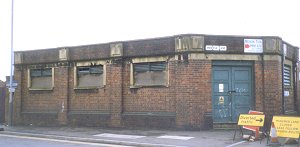
9. Willenhall Road/Minerva Lane |
That key difference apart, many of the same
features apply as in the previous group, notably diversity, and
close attention to detailing.
It is striking that, as regards our major feature, the roof, our 5 examples possess no fewer than 3 different types, pitched, hipped and half-hipped. |
|
In the first 3 instances, vertical brickwork is again used to add
interest to the doorway; the first 2 employ the decorative effect
of tiles inserted horizontally at the eaves.
Noteworthy is that the half-hipped design (13), which in style and detailing is the most complex, is the standard model of which I have found several examples. |
10. Hollybush Lane, top end |
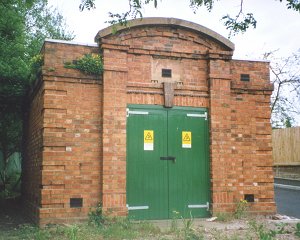
11. Barn Green, off Birches Barn Road |
Yet perhaps the most interesting individual cases
are numbers 15 and 16, for these have traits particularly
associated with contemporary suburban houses.
In both, there are rendered walls with brick intrusions, and in the second, mock timber-framing of the gable end. The extent to which the Sub-Stations are a faithful reflection of contemporary building style could not be more clearly demonstrated. |
Supporting Features.
It is not just as exemplars of contemporary "modernist" or "domestic" style that the Sub-Stations are a distinctive and valuable part of the townscape. Each has its own curtilage, in some cases extensive.
|
As these areas are not subject to gardening or
other great maintenance, they readily develop, particularly in the
suburbs, into small oases of semi-wild vegetation bordering on the
picturesque (6, 7, 13, 14, 15, 16).
Being similarly free of the ever-changing demands of "home improvement", the Sub-Stations tend to retain original pre-War features which used to be common in the surrounding houses, but now have been mostly done away with, such as wooden gates (4, 6) and palisades, either varnished or painted. |
12. Compton Road, by Oddfellows Inn |
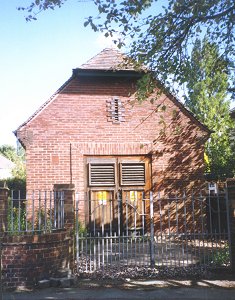
13. Canterbury Road (same as one in Highlands Road) |
The use of a particular green paint, especially on doors, is itself one of the foremost identifiers of an electricity facility (1, 2, 3, 4, 7, 8, 9, 10,11,12, 15, 16, App.1). Not only was green perhaps the most typical colour in inter-War home decoration, it also seems to have been the trademark colour of the Wolverhampton Electricity Department, visible not least on the Department s street pillars or "Lucy boxes" of the period; thus on two counts the retention of that paint on Sub-Stations is witness to the Borough s historic heritage. Paint was not the only finish however; in some cases, varnish was applied to doors, which suggests that they were of hardwood not softwood (5, 6, 13, 14). This would be an impressive case of the use of fine quality materials in such apparently humble structures, with undeniably attractive results. |
|
Nor does the case end there: the associated door
furniture is of good contemporary design and quality, apparently
in brass or a related alloy.
Likewise several Sub-Stations appear to share a standard entrance, boasting a fine curved brick approach with cast iron railings, and an elegant cast iron gate (13). As it happens the gateway illustrated has been removed since this photograph was taken, and replaced by something more solid and, to my eye, vastly less attractive. |
14. Mount Road, Penn |
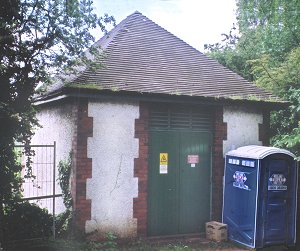
15. Wightwick |
This forcibly makes the point that the various
features summarised in this paragraph, minor though they seem,
still contribute significantly to our city landscape.
That supports the local listing of some Sub-Stations, a suggestion which I have put forward to the City Council. These Sub-Stations are an important element of Wolverhampton's history and heritage, as well as telling examples of inter-War building style. |
| As an Appendix to this article, I show below two buildings associated with the electricity industry which are not simple sub-stations. I will add further information about them when it becomes available. |
16. Compton Road |
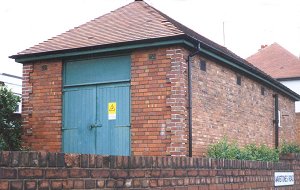 |
left: Warstones Road, south end |
| right: Wellington Road, Bilston |
|